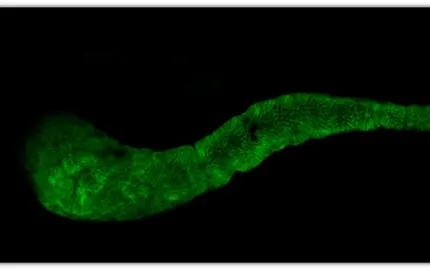Presentation

We work at the intersection of immunology and developmental biology.
Using the zebrafish, we study how immune signals such as cytokines crosstalk with microbial and environmental signals to control the development, maturation, and physiology of mucosal tissues, with particular focus on the gut
For more information, please visit the personal website of the lab
Mucosal cytokines and innate lymphoid cells (ILCs):
Cytokines mediate intercellular communication by binding target cell receptors and activating downstream signaling pathways. In addition to their well-described role in immunity, growing evidence indicates that they also mediate organ homeostasis in barrier tissues such as the gut. Most cytokines with central roles in gut immunity and homeostasis in humans have ortholog genes in zebrafish. These include several genes linked to inflammatory bowel disease (IBD) in humans. Thus, the zebrafish offers a valuable opportunity to study the role of cytokines in gut development, growth, maturation and physiology.
In mice and humans, a novel leukocyte family named innate lymphoid cells (ILCs) was identified and found to permanently reside in the gut, lungs and other mucosal tissues. ILCs are potent sources of cytokines that control epithelial expression of genes involved in defense against pathogens, cell proliferation, cell death, nutrient absorption, and other processes. However, whether and how ILCs regulate gut development, growth, homeostasis and physiology is unknown mainly due to the lack of ILC-specific markers to precisely target these cells. We discovered that cytokine-expressing ILCs also exist in the zebrafish gut and identified ILC-specific markers. We are exploiting these advantages to dissect the function of ILCs in vivo.
In addition to ILCs and epithelial cells, gut cytokines have several cellular sources and target cells. We are deciphering the signals and pathways that control cytokine expression in hematopoietic and non-hematopoietic cells, including epithelial cells, and studying how cytokine networks control gut maturation and physiology.
Microbiota-cytokine crosstalk:
While still developing, the gut opens to the external environment, and continues to grow in interaction with several commensal microorganisms. These microorganisms —the microbiota— induce gut maturation, including that of its immune and epithelial cell compartments. In addition, imbalanced gut microbiota composition, called dysbiosis, has been implicated in a wide range of diseases including inflammatory bowel disease (IBD), obesity, allergic disorders, Type 1 diabetes mellitus, autism, obesity, and colorectal cancer in both human and animal models. However, the signals and mechanisms by which the microbiota modulates the development and physiological homeostasis of host tissues are not well understood. Challenges to answer these questions include the technical limitations for the direct observation and manipulation of the microbiota and microbiota-host interactions during postembryonic development. Unlike other vertebrate models, it is easier and cheaper to generate germ-free animals and manipulate the environment in zebrafish, allowing to combine multiple experimental conditions. Exploiting these advantages, we study how the microbiota-cytokine crosstalk modulates gut maturation and physiology.
Ontogeny and function of hematopoietic waves:
During development, immune cells originate at different sites and in successive waves. Of note, using the zebrafish and mouse models, it was shown that certain embryonic myeloid and lymphoid subpopulations do not derive from hematopoietic stem cells (HSCs) and that some of these cells persist in the adult. The specific function of cells derived from each of these successive waves is not yet understood. Using microscopy and genetic tools, we study how ontogenetically distinct innate immune cells modulate the development, physiology, and homeostasis of tissues.
The zebrafish and our approach
The zebrafish is an ideal animal model for studying vertebrate development due to its easy genetic manipulation, large progeny, transparency and rapid ex utero development. The transcriptional regulatory networks controlling gut development, structure and physiology are highly conserved between fish and mammals. The zebrafish has also recently emerged as a powerful model system for studying vertebrate gut physiology as well as microbiome assembly, dynamics and function. In addition, most immune lineages and pathways are conserved between fish and mammals, and our work revealed a high degree of conservation between the human and zebrafish ILC families.
We are establishing novel optogenetic tools to control gene expression and perform lineage-tracing experiments of hematopoietic and non-hematopoietic cells of different tissues and anatomical locations of the zebrafish embryo and larvae. Also, we are generating new tools for genome-editing and locus-specific transgenesis.
In summary, technologically, we are taking advantage of cutting-edge methodologies combining live microscopy, optogenetics, transcriptomics, gene-editing together with microbiota manipulation. Conceptually, we integrate paradigms and know-how from fields such as developmental biology, cell biology, immunology, and gut physiology




















 2021
2021



